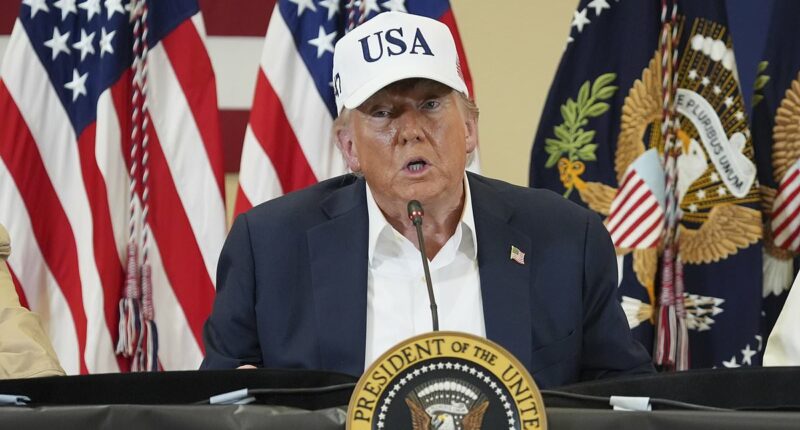Share this @internewscast.com
Donald Trump has enacted extensive tariffs on the United States’ largest trade partners, claiming that trade deficits pose a ‘major threat’ to the American economy.
The president announced he will be placing a 30 percent tariff rate on imports from Mexico and the European Union.
In correspondence with European Commission President Ursula von der Leyen and Mexican President Claudia Sheinbaum, Trump disclosed that these tariffs will be implemented starting August 1.
The EU had hoped to reach a comprehensive trade agreement with the US for the 27-country bloc.
Trump claimed the EU had the ‘largest trade deficits’ with the US.
‘Nonetheless, we have decided to proceed, but only under a more balanced and fair TRADE scheme,’ he stated. ‘Please note that the 30 percent figure is significantly lower than what is necessary to address the Trade Deficit disparity we experience with the EU.
‘This Deficit is a major threat to our Economy and, indeed, our National Security!’
The Republican offered the EU to build manufacturing facilities in the US, which would eliminate the 30 percent tariff, which only applies to products coming into the country.
He said those facilities could be approved as quickly as a ‘matter of weeks.’

In a Friday letter to the President of the European Commission, Ursula von der Leyen , Trump announced the US would be placing a 30 percent tariff rate on the European Union starting August 1

The EU had hoped to reach a comprehensive trade agreement with the US for the 27-country bloc. Trump claimed the EU had the ‘largest trade deficits’ with the US (pictured: Ursula von der Leyen)


The Republican offered the EU to build manufacturing facilities in the US, which would eliminate the 30 percent tariff, which only applies to products coming into the country. He said those facilities could be approved as quickly as a ‘matter of weeks’
Earlier this week, Trump issued new tariff announcements for a number of countries, including Japan, South Korea, Canada and Brazil, as well as a 50 percent tariff on copper.
Trump threw a grenade on the tariff negotiations between the United States and Canada with a blistering letter to Prime Minister Mark Carney on Thursday.
The two nations have been trying to settle the tariff war that broke out when Trump returned to office and announced plans to reorganize world trade.
Canadian officials had hoped a deal was close, but Trump’s latest letter – which he shared to Truth Social on Thursday night – has set negotiations back to square one.
The letter revealed he would raise tariffs on Canadian products to 35 percent from August 1 – a 10 percent increase on the current levy.
Trump said the tariff hike was in part due to the fentanyl crisis and Canada’s ‘failure to stop the drugs from pouring into our country.’
‘I must mention that the flow of fentanyl is hardly the only challenge we have with Canada, which has many tariff, and non-tariff, policies and trade barriers,’ Trump wrote in the letter.
Trump said ‘the fact the United States has agreed to continue working with Canada, despite Canada having financially retaliated against the United States’, demonstrates the ‘deep commitment to our trading relationship.’

Trump threw a grenade on the tariff negotiations between the United States and Canada with a blistering letter to Prime Minister Mark Carney on Thursday. The letter revealed he would raise tariffs on Canadian products to 35 percent from August 1
The letter did include a warning shot to Carney, vowing to continue upping the US tariffs if Canada was to impose retaliatory taxes.
He said he would consider ‘an adjustment to this letter’ if ‘Canada works with me to stop the flow of Fentanyl.’
‘These tariffs may be modified, upward or downward, depending on our relationship with your country,’ he added.
The latest round of tariffs are in addition to previously imposed sectoral tariffs on steel, copper and aluminum, which came into effect for most countries on June 4 at a whopping 50 percent.
Trump’s punishing hike sparked fears American households would see an increase in costs for everyday items, given foreign-made steel and aluminum is used in household products like soup cans and paper clips, as well as big-ticket items like a stainless-steel refrigerators and cars.
The two metals had previously faced 25 percent tariffs worldwide since mid-March, when Trump’s order to remove steel exemptions and raise aluminum’s levy went into effect.




